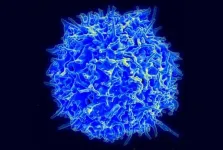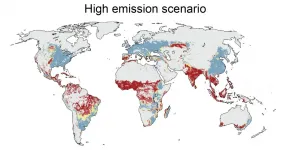(Press-News.org) The United States has witnessed a steep rise in reports, arrests, and media coverage of teachers' sexual misconduct with students. A new study investigated the impact of perpetrators' gender, sexuality, and age on perceptions of teacher sexual misconduct. The study found that
responses to teachers' misconduct varied according to certain characteristics, which can influence whether victims report the misconduct.
The study, by researchers at Prairie View A&M University and the University of Nevada, Reno, appears in Feminist Criminology.
"Because sexual abuse of a child or adolescent in any context has substantial psychological, emotional, and physical consequences for the victim, teachers' sexual misconduct is a serious public health concern," says Kristan N. Russell, assistant professor of justice studies at Prairie View A&M University, who led the study. "Yet very little research has been done to examine the factors that affect how these cases are perceived."
Public perceptions are important, Russell argues, because they may contribute to the stigma experienced by victims, and also affect the willingness of victims to disclose or report these types of cases. Public perceptions also inform legal decision making regarding these cases.
The study's 495 respondents were recruited through a crowdsourcing website in 2019. They were over the age of 18 (average age was 36 years old) and predominantly White (60 percent), male (60 percent), and heterosexual (74 percent).
Respondents were asked to read one of eight randomly assigned fictional newspaper articles describing a case of a local teacher who engaged in sexual misconduct with a 17-year-old student. The articles described forms of nonsexual contact (sending nude photos and sexting) and forcible rape. Then the respondents answered questions about their perceptions of the case and their general attitudes toward cases of this type.
The articles varied by gender of the teacher (male or female), gender pairing of the teacher and student (opposite gender/heterosexual or same gender/homosexual), and age of the teacher (26 or 52 years). The pictures of the teacher, which were stock photos, varied by gender and age.
Although the study did not find evidence of significant interactions between gender, sexuality, and age, it did find that each of these factors affected respondents' perceptions. Specifically:
When the teacher was a woman, respondents perceived the relationship to be less detrimental to the student, the student to be more mature and responsible, and the relationship to be more acceptable.
Heterosexual pairings were perceived as more acceptable than same-sex pairings, with the student perceived as more mature and responsible in heterosexual pairings.
When the teacher was older, respondents perceived the teacher as more responsible and the student as having psychological issues contributing to the reasons for participating in the interaction. The age of the teacher did not relate significantly to respondents' perceptions of the impact of the relationship on the student.
The findings suggest that harmful aspects of teachers' sexual misconduct may be downplayed when the teacher is a woman, leading to underreporting of this type of misconduct by victims, the authors note. In addition, gender pairing affects perceptions, with heterosexual relationships less likely to be reported than homosexual relationships. This illustrates the persistence of stereotypes that depict gay people as predatory or pedophilic, and this, too, may contribute to reduced disclosure by victims in an effort to avoid stigmatization.
"Our findings can be used to develop trainings to inform teachers and students about the factors that influence perceptions and may contribute to underreporting, and strategies for intervening and reporting," suggests Kjerstin Gruys, assistant professor of sociology at the University of Nevada, Reno, coauthor of the study. "We hope that by educating people about what to be aware of in terms of laws and consent, and by allowing systematic and anonymous forms of reporting, students and staff can feel comfortable and safe reporting crimes."
INFORMATION:
Developing self-healing materials is nothing new for Nancy Sottos, lead of the Autonomous Materials Systems Group at the END ...
Three billion years ago, light first zipped through chlorophyll within tiny reaction centers, the first step plants and photosynthetic bacteria take to convert light into food.
Heliobacteria, a type of bacteria that uses photosynthesis to generate energy, has reaction centers thought to be similar to those of the common ancestors for all photosynthetic organisms. Now, a University of Michigan team has determined the first steps in converting light into energy for this bacterium.
"Our study highlights the different ways in which nature has made use of the basic reaction ...
May 14, 2021 - Two thirds of all pediatric spinal fractures, especially in the adolescent population, occur in motor vehicle accidents (MVAs) where seatbelts are not utilized, reports a study in Spine. The journal is published in the Lippincott portfolio by Wolters Kluwer.
"Over 60 percent of pediatric spinal fractures occur in children ages 15 to 17, coinciding with the beginning of legal driving," according to the new research by Dr. Vishal Sarwahi, MD, of Cohen Children's Medical Center, New Hyde Park, NY, and colleagues. They emphasize the need for measures to increase seatbelt usage, particularly by younger drivers, and outline the potential trauma that can be avoided through proper seatbelt use.
Seatbelts save lives... and ...
May 14, 2021 - Two years ago, the Veterans Affairs healthcare system (VA) began rolling out a new benefit, enabling Veterans to receive urgent care from a network of community providers - rather than visiting a VA emergency department or clinic. Progress toward expanding community care services for Veterans is the focus of a special supplement to the May issue of Medical Care. The journal is published in the Lippincott portfolio by Wolters Kluwer.
The urgent care benefit "provides a new way to deliver unscheduled, low-acuity acute care to Veterans," according to the ...
A team led by researchers at Weill Cornell Medicine and Children's National Hospital has developed a unique pre-clinical model that enables the study of long-term HIV infection, and the testing of new therapies aimed at curing the disease.
Ordinary mice cannot be infected with HIV, so previous HIV mouse models have used mice that carry human stem cells or CD4 T cells, a type of immune cell that can be infected with HIV. But these models tend to have limited utility because the human cells soon perceive the tissues of their mouse hosts as "foreign," ...
The question of why we dream is a divisive topic within the scientific community: it's hard to prove concretely why dreams occur and the neuroscience field is saturated with hypotheses. Inspired by techniques used to train deep neural networks, Erik Hoel (@erikphoel), a research assistant professor of neuroscience at Tufts University, argues for a new theory of dreams: the overfitted brain hypothesis. The hypothesis, described May 14 in a review in the journal Patterns, suggests that the strangeness of our dreams serves to help our brains better generalize our day-to-day experiences.
"There's obviously an incredible number of theories of why we dream," says Hoel. "But I wanted to bring to ...
Rodents and pigs share with certain aquatic organisms the ability to use their intestines for respiration, finds a study publishing May 14th in the journal Med. The researchers demonstrated that the delivery of oxygen gas or oxygenated liquid through the rectum provided vital rescue to two mammalian models of respiratory failure.
"Artificial respiratory support plays a vital role in the clinical management of respiratory failure due to severe illnesses such as pneumonia or acute respiratory distress syndrome," says senior study author Takanori Takebe (@TakebeLab) of the Tokyo Medical and Dental University and the Cincinnati Children's Hospital Medical Center. "Although the side effects and safety need to be thoroughly ...
Climate change is known to negatively affect agriculture and livestock, but there has been little scientific knowledge on which regions of the planet would be touched or what the biggest risks may be. New research led by Aalto University assesses just how global food production will be affected if greenhouse gas emissions are left uncut. The study is published in the prestigious journal One Earth on Friday 14 May.
'Our research shows that rapid, out-of-control growth of greenhouse gas emissions may, by the end of the century, lead to more than a third of current global food production falling into conditions in which no food is produced today - that is, out of safe climatic space,' explains Matti Kummu, professor of global water and food issues at Aalto University.
According ...
What The Study Did: Researchers analyzed changes in filled prescriptions for naloxone (medication to reverse opioid overdoses) during the COVID-19 pandemic in the United States and compared them with changes in opioid prescriptions and overall prescriptions.
Authors: Ashley L. O'Donoghue, Ph.D., of the Beth Israel Deaconess Medical Center in Boston, is the corresponding author.
To access the embargoed study: Visit our For The Media website at this link https://media.jamanetwork.com/
(doi:10.1001/jamahealthforum.2021.0393)
Editor's Note: The ...
What The Study Did: Associations of staffing and testing interventions with COVID-19 transmission in nursing homes are examined in this decision analytical modeling study.
Authors: Rebecca Kahn, Ph.D., of the Harvard T.H. Chan School of Public Health in Boston, is the corresponding author.
To access the embargoed study: Visit our For The Media website at this link https://media.jamanetwork.com/
(doi:10.1001/jamanetworkopen.2021.10071)
Editor's Note: The article includes conflict of interest and funding/support disclosures. Please see the article for additional information, including other authors, author contributions and affiliations, conflict of interest and financial disclosures, ...


